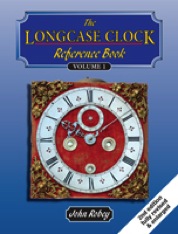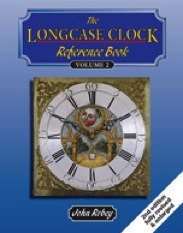


BUY THIS BOOK
The Longcase Clock Reference Book
by
John Robey
This fully revised and enlarged second edition of The Longcase Clock Reference Book considers all aspects of the longcase clock, from the late seventeenth century to the Victorian era.
The first volume studies the clock trade, and how it was organised, both in the large cities and rural areas. It is shown that clockmakers relied heavily on the services of other craftsmen: brass founders, iron forgers, pinion makers, engravers, and cabinet-makers, as well wholesale suppliers of clock parts. How a longcase clock was actually made in the eighteenth-century is discussed and compared with present-day methods.
Several chapters detail movements, both their time-keeping and striking systems, with numerous variations. Chiming and musical clocks are included, as well as moon work, calendars, simple automata and alarms. This book is unique in showing many aspects of longcase clock movements that have not been recorded elsewhere. Also considered are the movements for painted-dial clocks and who made them — a topic that has received little attention, despite the growing interest in this type of clock.
The second volume discusses the stylistic development of brass dials made in both London and the provinces, including those for simple rural thirty-hour clocks. Painted dials are also covered in detail with much new information on dialmakers in Birmingham and elsewhere.
Fashionable clock cases were made in London using walnut, ebony, lacquer or mahogany, while elsewhere regional styles developed often in oak or other timbers. These are all considered, as well as some interesting and unusual clocks. Longcase clocks made for special purposes are included as well as those with wooden movements.
Throughout this book there is emphasis on the practical aspect — not only how movements, dials (both brass and painted), and cases developed stylistically, but how they were actually made. American tall-case clocks are compared and contrasted with their British counterparts.
These two volumes are illustrated by over 2,500 illustrations, many in colour, including numerous specially drawn diagrams of clock mechanisms. With many charts and tables it is an indispensable reference work on the longcase clock for horologists, collectors and restorers.
Contents
The Development of the Longcase Clock (15pages, 25 illustrations)
An introduction to the development of the longcase clock
Clockmakers & The Clock Trade (85 pages, 106 illustrations)
Clocksmiths, blacksmiths, and others who also made clocks as well as clockmakers. Trade guilds, the Clockmakers’ Company, casemakers, dial engravers, components suppliers, clock-brass founders, casting marks on clock parts, pinion makers, clock iron-forgers, hand makers, etc
The Clockmaker At The Bench (49 pages, 146 illustrations)
How clocks were made during the seventeenth, eighteenth and nineteenth centuries, the materials and the tools used by the clockmaker. Examples of plates and pillars to help date and identify movements. How longcase clock wheels were cut and depthed
Movements: Timekeeping (58 pages, 248 illustrations)
Pendulums, rating adjustment, escapements, going trains, maintaining power, motion work, and strike let-off
Movements: Striking The Hour (78 pages, 228 illustrations)
Countwheel and rack striking, including many unusual and ingenious arrangements. Strike/silent mechanisms, bells and hammers
Striking & Chiming Quarters & Playing Music (36 pages, 73 illustrations)
Two-train quarter striking, three-train and four-train chiming and musical clocks
Calendars, Moon Phase, Simple Automata & Alarms (59 pages, 199 illustrations)
Simple once-a-day, twice-a-day and pointer calendars, rolling moons, penny moons, globe moons and operating mechanisms
Movements for Painted-Dial Clocks (42 pages, 108 illustrations)
Hand-crafted movements and those made for the trade, by known and unknown makers. Lists of names stamped on movements
Brass Dials (130 pages, 409 illustrations)
How brass dials were made. London square and arched dials, also provincial square, arched, round, thirty-hour and country dials, Bristol dials. Spandrels and hands
Painted Dials (139 pages, 379 illustrations)
Techniques for producing painted dials, a complete list of dialmakers, falseplates, the development of dial decoration. Moons and hemisphere maps
Clock Cases (152 pages, 429 illustrations)
Fashionable London cases, also provincial and rural longcases. Case construction
Interesting, Unusual & Special Purpose Clocks (57 pages, 153 illustrations)
Includes interesting domestic clocks, mill clocks, nocturaries and wooden movements
Bibliography (2 pages)
Index (15 pages)
The author
John Robey has written numerous articles in Antiquarian Horology, Horological Journal and Clocks magazine on a wide range of horological subjects, and is also the author of Gothic Clocks to Lantern Clocks. For his contributions to horological research, writing and publishing he was awarded the British Horological Institute’s Barratt Silver Medal in 2007 and an HonFBHI in 2022.
